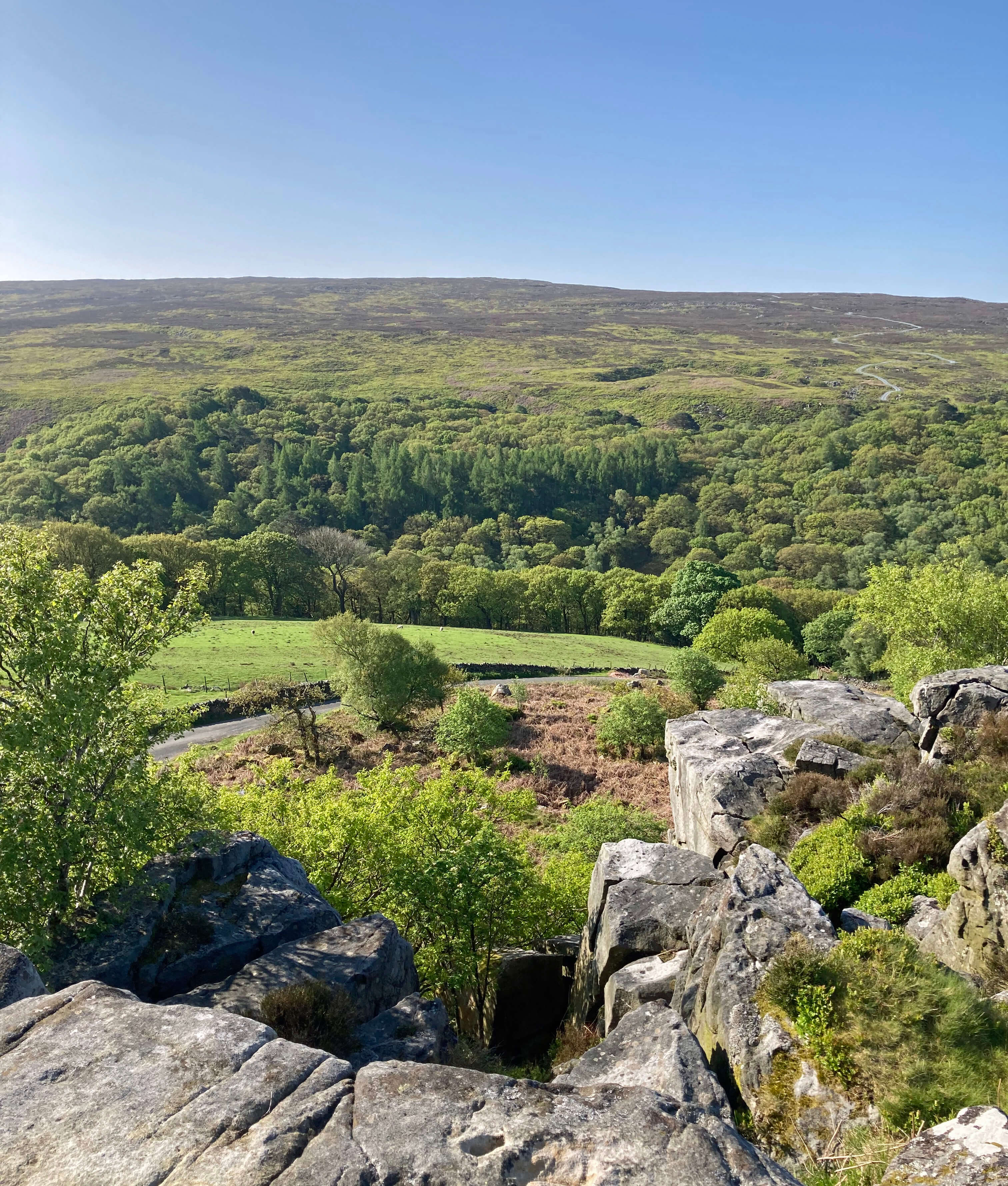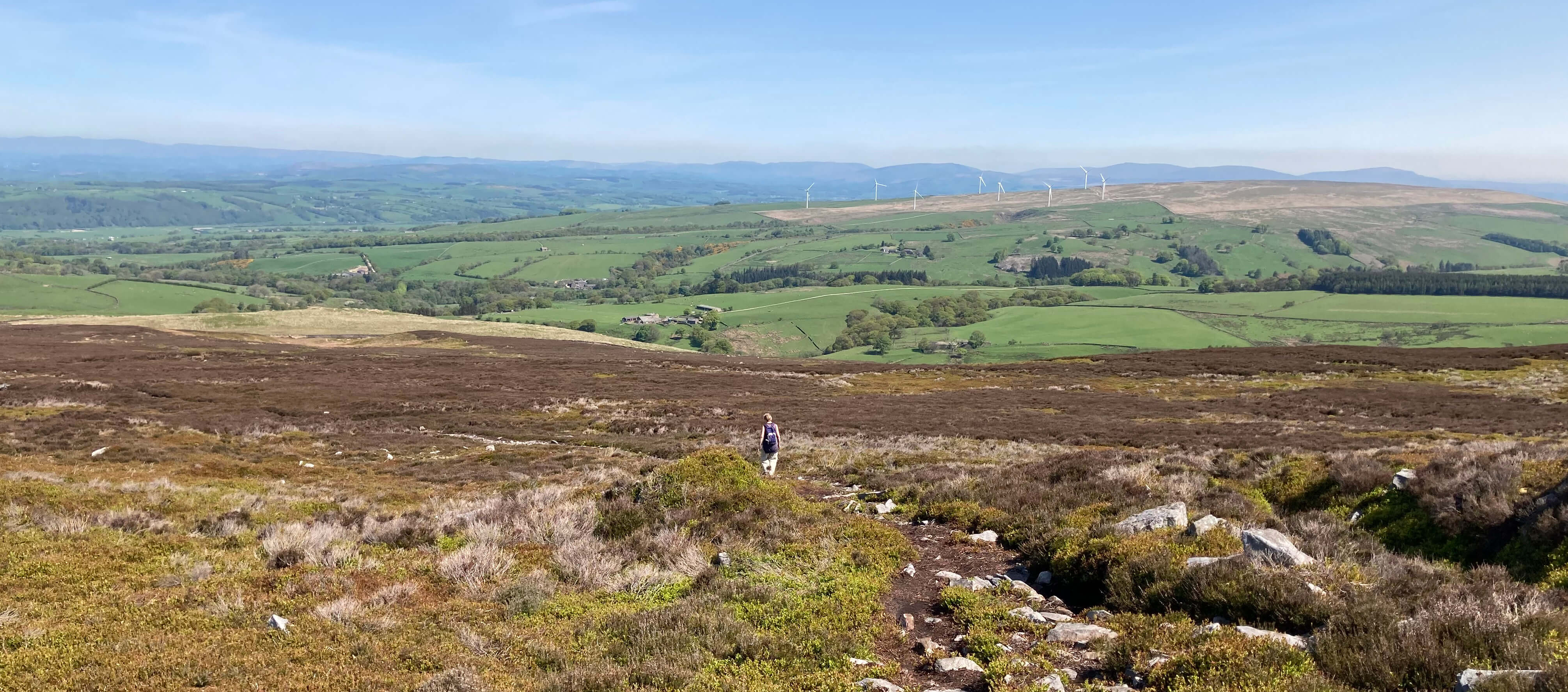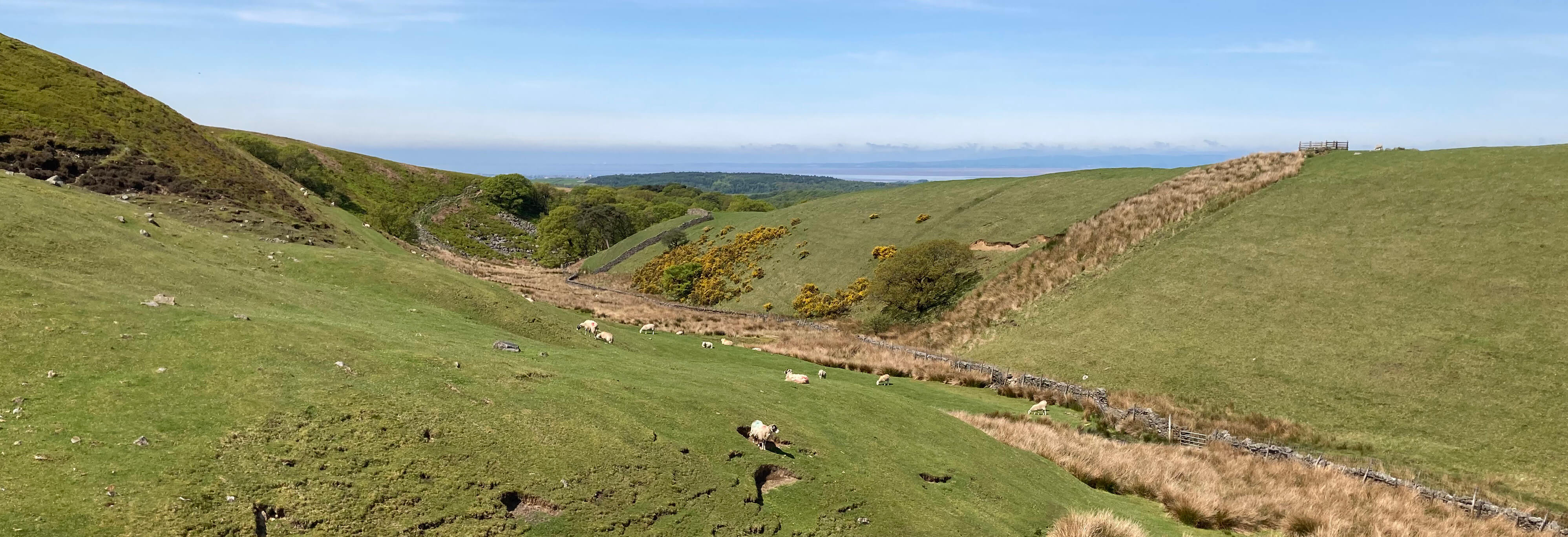
Home
Preamble
Index
Areas
Map
References
Me
Drakkar
Saunterings: Walking in North-West England
Saunterings is a set of reflections based upon walks around the counties of Cumbria, Lancashire and
North Yorkshire in North-West England
(as defined in the Preamble).
Here is a list of all Saunterings so far.
If you'd like to give a comment, correction or update (all are very welcome) or to
be notified by email when a new item is posted - please send an email to johnselfdrakkar@gmail.com.
176. The Cragg – Clougha Cuckoo Circuit
 Right: Looking from Baines Cragg, over Cragg Wood, to Clougha.
Right: Looking from Baines Cragg, over Cragg Wood, to Clougha.
It is six months since I walked up a hill, unless you count Nicky Nook (215 metres)
[Sauntering 170] or
family rambles on Loughrigg Fell (335 metres) and Caton Moor (361 metres). Before I travel
to tackle high mountains I need to get some up-and-down action into my legs. So we set off
to The Cragg for a circuit on the moors below Clougha.
Looking south from Little Cragg, the walk seems straightforward – walk up the hill on
the right side, across the top, and back down on the left side. We headed for Baines Cragg, as
we did during the first covid lockdown [Sauntering 91] to listen for cuckoos. On that occasion the view
was crystal clear but today a polluted murk all but obscured the distant hills. But, as last
time, as we stood there we heard a cuckoo, which is always a cheering experience.
Those who philosophise about the benefits of walking often emphasise that it enables
an escape from the woes and worries of everyday life. However, I am
not escaping from anything. Often, especially when walking over familiar terrain, I am not
cocooned in the here-and-now experience but open to an amalgamation of
memories of past activities within my ‘everyday life’.
It is, for example, impossible for me to visit The Cragg in May without recalling
our previous pilgrimages to hear the cuckoos. We would come with a picnic, or with
a meal to cook in the camper van, to enjoy to the sound of cuckoos. At other times of the
year The Cragg would be the objective for a family outing, with the children free to
clamber over the rocks. Our visitors were liable to be whisked up to The Cragg. I remember my
mother sitting there, somewhat nonplussed by the view of rather bleak heather moors. She
rarely left Norfolk. On the journey here from Norfolk she had been puzzled by the apparent
absence of the Pennines, which she had been led to believe was a mighty mountain range that split
the country in two. I was able to assure her that she was looking at a part of the Pennines
and, even if it may not have looked much to her, it is over five times higher than anywhere
in Norfolk.
The Cragg also has more personal memories for me. On Sunday mornings I often ran
up to The Cragg, down the other side, completed a loop, and then ran back up and over The
Cragg. While others gave thanks to the almighty in church, I thought of myself giving
thanks for health and nature, in my own way.
I also often ran over The Cragg
to get home from Lancaster University, thereby avoiding the traffic. On one occasion,
though, I was passed by a car as I toiled up the slopes on a very hot day. At the top, I
was greeted by the driver, the farmer’s wife of The Cragg farm, standing, waiting for me,
with a large glass of orange juice. Actually, I am sure she was a farmer too but if I
just said ‘farmer’ you’d assume a man,
wouldn’t you? After all, according to the nursery rhyme, “the farmer wants a wife”. I digress.
My point is that this walk, straightforward as it may seem, means more to me.
We walked down past the increasingly dilapidated Bark Barn, noting the distinctive
gate in the wall indicating that we were above the Thirlmere Aqueduct, which we had traced
in another lockdown walk [Sauntering 89]. Various structures in the field are presumably to do with
the aqueduct. At Cragg Cottage we were disappointed not to see or hear the peacocks which
for long have been a distinctive feature here. But then as we walked up to the moor we
heard the loud alien sound of a peacock from deep within Cragg Wood, a sound that must
puzzle visitors who don’t know about the peacocks.
The moor seemed a deeper, more luxuriant green than it used to be. This, we
surmised, is because the bilberry is able to grow into what are becoming small bushes now
that there are few, or no, sheep on these slopes. The heather, higher up, seemed healthy
too with no signs of recent burning. Perhaps the estate-owners have reduced, or ended,
this practice. If so, and if this continues, then these moors will look rather different
in a decade or two’s time, with shrubs and eventually trees colonising and with consequent
changes in the wildlife that makes a home here.

Looking back to Baines Cragg, over Cragg Wood, from the Clougha slopes (with The Cragg
farm below the windmills)
We walked slowly up and up, on the shooters’ track. Of course, in earlier decades
we weren’t allowed on these moors at all. This track wasn’t then such a visible scar on
the landscape but at least it now provides a convenient path uphill for walkers. We disturbed
the occasional grouse and also a family with tiny, striped chicks. The parents too are quite
attractive birds really but, sadly for them, they are always associated with shooting.
The path curved south-east and levelled off. At about 400 metres we were now more
or less on the horizon as seen from The Cragg. The breeze was so slight that only
occasionally did it stir one of the Caton Moor windmills into action. It was not sufficient to
disperse all the low-lying murk but we could at least now see the grey shapes of the
distant hills of the Lakes and Dales. Nearer, the farmers’ fields looked a deep green
below the dull brown of the heather.
We looked out for the large rock outcrop to the left of the track which we knew was
where a path, otherwise easily missed, dropped north and led, eventually, back to The
Cragg. This was the path that I had walked up in snow in February 2020, just before the
first covid lockdown [Sauntering 75]. This path was more enjoyable to walk upon than the shooters’
track. The latter is easier-going but becomes a trudge – not a moorland walk at all.
We paused occasionally to look at green hairstreak butterflies – which we had seen in
much greater numbers on another lockdown walk, on Claughton Moor [Sauntering 87].

On the path down from Clougha

The valley where the River Conder begins
The path drops down into the valley where the River Conder begins its journey
west (and where I walked when I traced the Conder from the sea to its
source [Sauntering 70]). We turned east by the charming Sweet Beck.
At Skelbow Barn Ruth commented that the barn, now, it seemed, unused, would be a good
home for swallows – as I had said earlier that I hadn’t noticed any swallows yet this year –
and right on cue one and then a second flew from the barn. Back at the car we felt our
up-and-down leg muscles had been adequately exercised.
But … we hadn’t heard any more cuckoos after the first five minutes of our walk.
This is a little worrying. Three days later I walked over The Cragg again but heard no
cuckoos. Did we hear the last Littledale cuckoo?
Date: May 13th 2023
Start: SD546618, Little Cragg car park (Map: OL41)
Route: W over Baines Cragg – Bark Barn – S, SE on shooters’ track – large
rock outcrop at grid reference 552596 – N, NW, NE, W – Skelbow Barn – NW – Little Cragg
Distance: 6 miles; Ascent: 280 metres
Home
Preamble
Index
Areas
Map
References
Me
Drakkar
© John Self, Drakkar Press, 2018-

Top photo: The western Howgills from Dillicar;
Bottom photo: Blencathra from Great Mell Fell


 Right: Looking from Baines Cragg, over Cragg Wood, to Clougha.
Right: Looking from Baines Cragg, over Cragg Wood, to Clougha.



